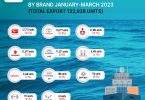
JAKARTA— Throughout the first quarter of 2017, the total CBU car exports showed a declining pace. Meanwhile, auto imports rose during the same period.
According GAIKINDO’s data, CBU car exports from Indonesia showed 15,611 units (January), 18,955 units (February), 21,863 units (March) and 18,518 units (April). CBU car exports from Indonesia in the form of several models are carried out by a number of manufacturers that have production facilities (manufacturing) in Indonesia. They are namely Daihatsu, Suzuki, and Toyota. Several export destination countries are ASEAN, Middle East and Japan.
But not all car manufacturers with manufacturing facilities in Indonesia emphasise in export market. For example, Mitsubishi, Isuzu, Hino, Honda, Hyundai, and Datsun/Nissan. They are still focusing production to improve the domestic market. Others are exporting but in the form of components that break down, such as Honda, Mitsubishi, and Isuzu.
Even for some models— especially sedans and sport utility vehicles (SUVs)— still rely on imports from Thai-based plants. Indonesia’s car imports in the first quarter of 2017 showed 4,102 units (January), 7,508 units (February), 8,308 units (March), 9,615 units (April). Imports are mainly made by car brands who do not build manufacturing facilities in Indonesia. They include Audi, BMW, FAW, Ferrari, Honda, Jaguar, Kia, Lamborghini, Land Rover, Lexsus, Mazda, Mercedes-Benz, Peugeot, Porsche, Renault, Scania, Tata, Volvo, UD Truck, VW.
For some models, like BMW and Mercedes-Benz has indeed been doing production of certain modelas in Indonesia. Still, they import some other models, to meet the range of consumer tastes.
Some constraints on car exports from Indonesia come from the issue of regulatory differences regarding emission thresholds. “Export destination countries are already implementing Euro 4 emission regulation while Indonesia will just implement it in 2018,” said Chairman of GAIKINDO Mr Yohannes Nangoi.
Another obstacle is the difference in consumers’ taste in the export destination countries most of whom pferfer sedan to other models. Meanwhile, some manufacturing facilities in Indonesia have long been producing MPV. Over the last few years GAIKINDO continues to communicate with the government to get tax breaks production of sedans in the country. (*)







